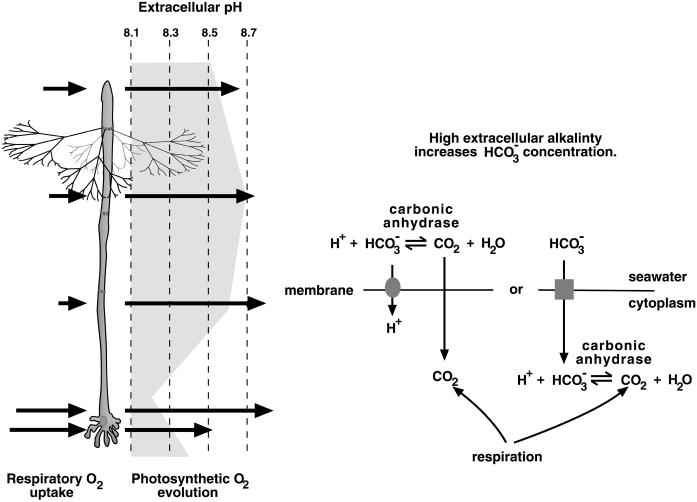Figure 1.
CA and inorganic carbon uptake. The shading next to the diagram of a late adult A. acetabulum (left) indicates extracellular alkalinity along the stalk (measurements made in artificial seawater at pH 8.1). The alga is drawn with only one whorl of hairs for clarity. The arrows on the left of the alga indicate oxygen uptake in the dark due to respiration and the arrows on the right indicate the pattern of photosynthetic oxygen evolution along the stalk (Serikawa et al., 2000). These measurements of extracellular pH and oxygen flux were made using self-referencing ion-specific micro-electrodes and represent the mean values measured from 13 individuals. The lengths of the arrows are proportional to the amount of oxygen flux. The external pH along most of the plant is alkaline relative to the surrounding medium, whereas the region at and near the rhizoid shows external acidity in nearly half of the individuals measured. The diagram (right) illustrates two potential roles for CA in inorganic carbon uptake when the extracellular medium is alkaline. In alkaline media, the equilibrium among forms of inorganic carbon shifts toward bicarbonate, leaving only a small pool of carbon dioxide available for diffusion across the plasma membrane into the cytoplasm (Badger and Price, 1994; Raven, 1995). Without CA activity, interconversion between bicarbonate and carbon dioxide occurs slowly and the carbon dioxide pool is quickly depleted. With extracellular CA activity, the interconversion is faster so that the pool of external carbon dioxide available for photosynthesis is continually replenished. If an alga actively takes up bicarbonate, internal CA activity can then convert that bicarbonate into carbon dioxide for use in photosynthesis. In addition, respiration can also provide inorganic carbon for photosynthesis.

